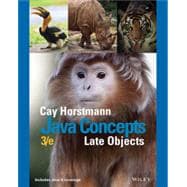Java Concepts: Late Objects, 3rd Edition focuses on the essentials of effective learning and is suitable for a two-semester introduction to programming sequence. This text requires no prior programming experience and only a modest amount of high school algebra. It provides an approachable introduction to fundamental programming techniques and design skills, helping students master basic concepts and become competent coders. Each important concept is introduced in easy-to understand terms before more complicated examples are discussed.
Choosing the enhanced eText format allows students to develop their coding skills using targeted, progressive interactivities designed to integrate with the eText. All sections include built-in activities, open-ended review exercises, programming exercises, and projects to help students practice programming and build confidence. These activities go far beyond simplistic multiple-choice questions and animations. They have been designed to guide students along a learning path for mastering the complexities of programming. Students demonstrate comprehension of programming structures, then practice programming with simple steps in scaffolded settings, and finally write complete, automatically graded programs.
The perpetual access VitalSource Enhanced eText, when integrated with your school's learning management system, provides the capability to monitor student progress in VitalSource SCORECenter and track grades for homework or participation.
*Enhanced eText and interactive functionality available through select vendors and may require LMS integration approval for SCORECenter.








